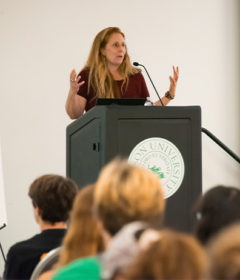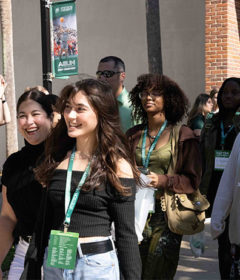Single-gender classrooms get good results
 As any parent or educator knows, boys learn differently from girls.
As any parent or educator knows, boys learn differently from girls.
But few have explored those gender differences as thoroughly as Stetson’s Nina B. Hollis Institute of Educational Reform. Ten years of study — in partnership with local schools — reveals that by organizing classrooms to address these differences, single-gender classes have unique advantages for boys and girls. A change in classroom structure may provide improved educational experiences for all students.
“The fact that this kind of program is available right here in Volusia County Public Schools is amazing, but I don’t think enough people are aware of it,” says teacher Laurie LaMonde. “We had film crews from Japan and Switzerland shooting footage in Woodward Elementary School. I think that’s a pretty big deal.” In addition, the study appeared on NBC Nightly News and prompted an article in People magazine.
“It’s brought a lot of national recognition for Stetson University,” according to Kathy Piechura-Couture, Ph.D., a professor of education at the Hollis Institute.
Stetson’s research was well ahead of the recent surge of interest in single-sex public education.
“The seed really began one spring when some of my teachers said, ‘If only we could separate the boys and the girls, we wouldn’t have as many problems,’ recalls JoAnne Rodkey, former principal of Woodward Elementary School in DeLand, who is now retired. “Beyond discipline issues, we started realizing the academic differences between them and wondered whether changing the classroom climate might facilitate better learning.”
Test scores revealed an academic gender gap favoring girls: Boys were lagging behind, particularly in reading and writing, and to a lesser extent, in mathematics.
As part of the professional development program that exists between the schools, Rodkey and her faculty approached Stetson about taking gender differences into account when designing and implementing instruction.
“The relationship between Woodward Elementary School and the university allows for innovation and research to occur,” Rodkey says.
First, the administration requested a waiver from the school board to offer single-sex classrooms as a parental choice under the “No Child Left Behind Act.” After receiving it, the school implemented a pilot study of three single-gender classes at various grade levels.
“My son was in the program for fourth and fifth grade,” says LaMonde. “Reading was more difficult for him, and he needed the structure that a single-gender classroom offered.”
One example: The all-boys class took “Brain Breaks,” two-minute, structured activities such as throwing a squishy ball around the classroom. Once the activity ended, boys were able to focus their attention back on academics.
Two years after participating as a parent, LaMonde herself volunteered to teach an all-girls third grade class at Woodward Elementary School.
“Girls are more chatty,” says LaMonde, who currently is working on her educational specialist degree in curriculum and instruction at Stetson. “For their ‘Brain Break,’ I’d give my girls two minutes to talk to their friends.”
After three years of data analysis, researchers report two clear patterns:
- Only the single-gender classrooms were found to have statistical significance.
- The effects of placing a student in a single-gender classroom were more beneficial to boys than girls.
Admittedly, the program is not for every boy or every girl, explains Bette Heins, Ph.D., director of the Hollis Institute. “Children process information in different ways. But I do believe that our work in elementary and middle school classrooms enhances what our faculty bring into Stetson University classrooms. It enriches all of us.”
by Renee Garrison



